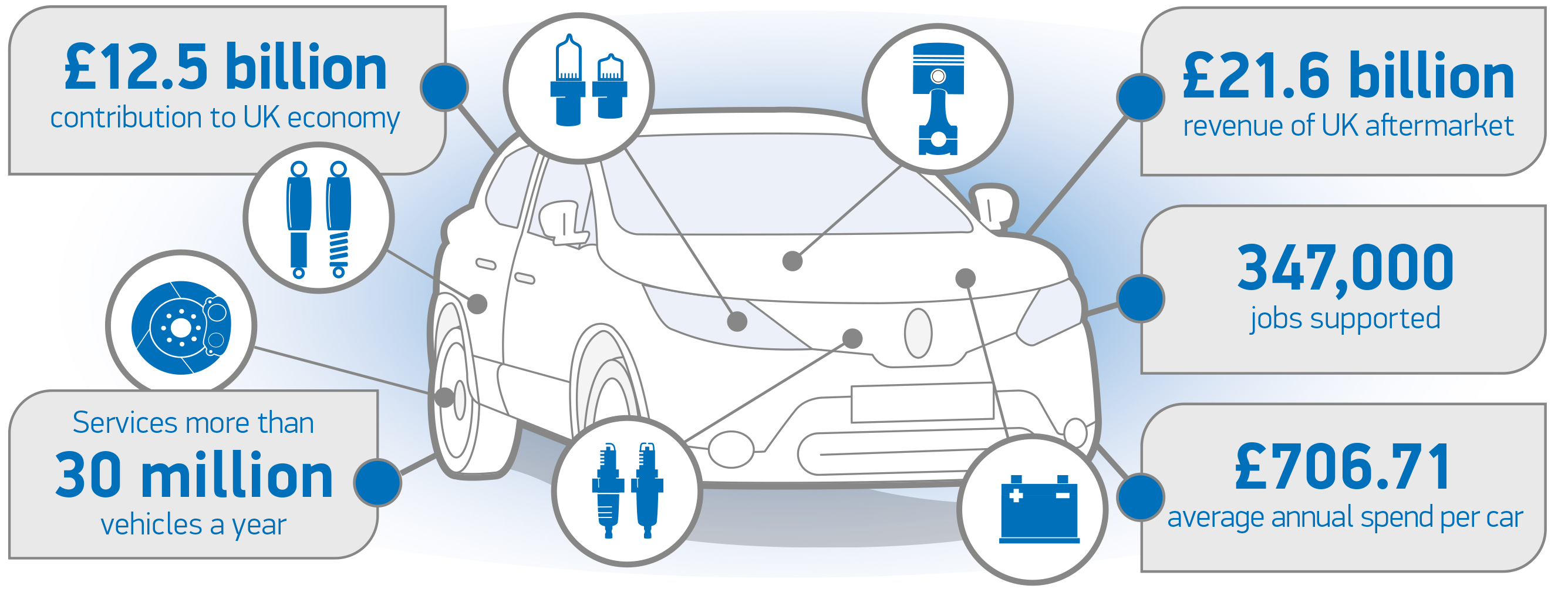- UK automotive aftermarket increases turnover to £21.6 billion as more high tech vehicles hit the road.
- Growing demand for digital services as British motorists buy more car parts, accessories and services online than cosmetics or groceries, new research reveals.
- Tyres, lubricants and filters still most commonly replaced parts, but demand for digital devices, including telematics and tyre pressure sensors growing fastest.
- Latest performance figures highlight record £12.5 billion economic contribution as second Automechanika Birmingham aftermarket and supply chain trade show opens.
The UK’s car servicing and repair sector grew again in 2016, with turnover rising 2.4% to £21.6 billion, according to figures released today by the Society of Motor Manufacturers and Traders (SMMT). Growth was primarily driven by sustained record numbers of new car registrations,1 and greater reliability, leading to more vehicles remaining on British roads for longer but still requiring regular servicing and maintenance. The increasing level of advanced technology in modern vehicles was also a major influencing factor.
New research, commissioned by SMMT from independent consultancy Frost & Sullivan, shows that in 2016, UK motorists increased their annual spending on car maintenance by 1.7% to an average of £707. This was due, in part, to the replacement of more high tech components, which require new skills and equipment to fit. While tyres, lubricants and filters are still the most commonly replaced items, the research shows that demand is rising fastest for telematics devices and tyre pressure monitoring sensors.2
The performance figures highlight the sector’s significant contribution to the UK economy. In 2016, the UK automotive aftermarket, which includes parts makers, distributors, retailers and workshops, grew its contribution to the economy by 2.5% to £12.5 billion and created 1,400 new jobs. The total number of livelihoods supported by the sector now stands at some 347,000 – more than the population of Coventry.3
The increasing digitalisation of cars and components presents challenges and opportunities to the sector as it strives to keep pace with advanced vehicle technology, data driven servicing and the changing needs of motorists. The research shows that British motorists are also leading the way in online car maintenance, with one of the fastest adoption rates in Europe. Last year, UK consumers bought a higher percentage of automotive parts, accessories and services online than they did cosmetics and groceries.1 Together they spent some £920 million on items such as tyres, brakes and batteries, and by 2022 this is forecast to rise by more than three quarters to £1.65 billion.
There is also consumer appetite for connected services such as vehicle health reports, fault detection and recall alerts, all of which make it easier to maintain cars. The research identifies growing interest in emerging forms of mobility such as car sharing schemes, forecast to attract some 2.3 million members worldwide by 2025, and e-hailing. Consumers are also increasingly turning to other digital services for their maintenance needs and online comparison websites, common in the insurance and finance sectors, are now entering the aftermarket. An estimated 100,000 people in the UK are currently using these sites to compare workshop offerings and prices, and this is set to grow significantly. This all makes clear the need for aftermarket companies to continue adapting their business models, and increasing their investment in mobile platforms to remain competitive.
Mike Hawes, SMMT Chief Executive, said,
“Today’s figures show just how vital the UK automotive aftermarket is to our economy and society, supporting hundreds of thousands of jobs and keeping vehicles safe – and the country moving. Our car maintenance sector is one of Europe’s most competitive, with vehicle owners enjoying more choice over where they have their cars serviced. The shift to digital vehicles and services will help drive this further, but the sector must continue to invest in the advanced skills, equipment and systems needed to stay abreast of evolving technology and changing mobility patterns.”
As the number and age of vehicles on UK roads increases, thanks to a strong new car market, ever-improving reliability and more complex servicing techniques, by 2022 the UK automotive aftermarket is projected to be worth some £28 billion, with an employee base of 400,000.
The news comes as the Automechanika Birmingham 2017 trade show opens its doors. Running from 6-8 June, the exhibition, which made its UK debut last year, will see tens of thousands of British and global investors and buyers visit more than 800 aftermarket and supply chain companies at the NEC.
1 2016 was the UK new car market’s fifth consecutive year of growth, with a record 2,692,786 new car registrations
2 Frost & Sullivan research shows telematics devices growing at 30-40% (CAGR) and tyre pressure monitoring systems growing at 20-30% (CAGR) 2015-2020
3 www.coventry.gov.uk (June 2017)









